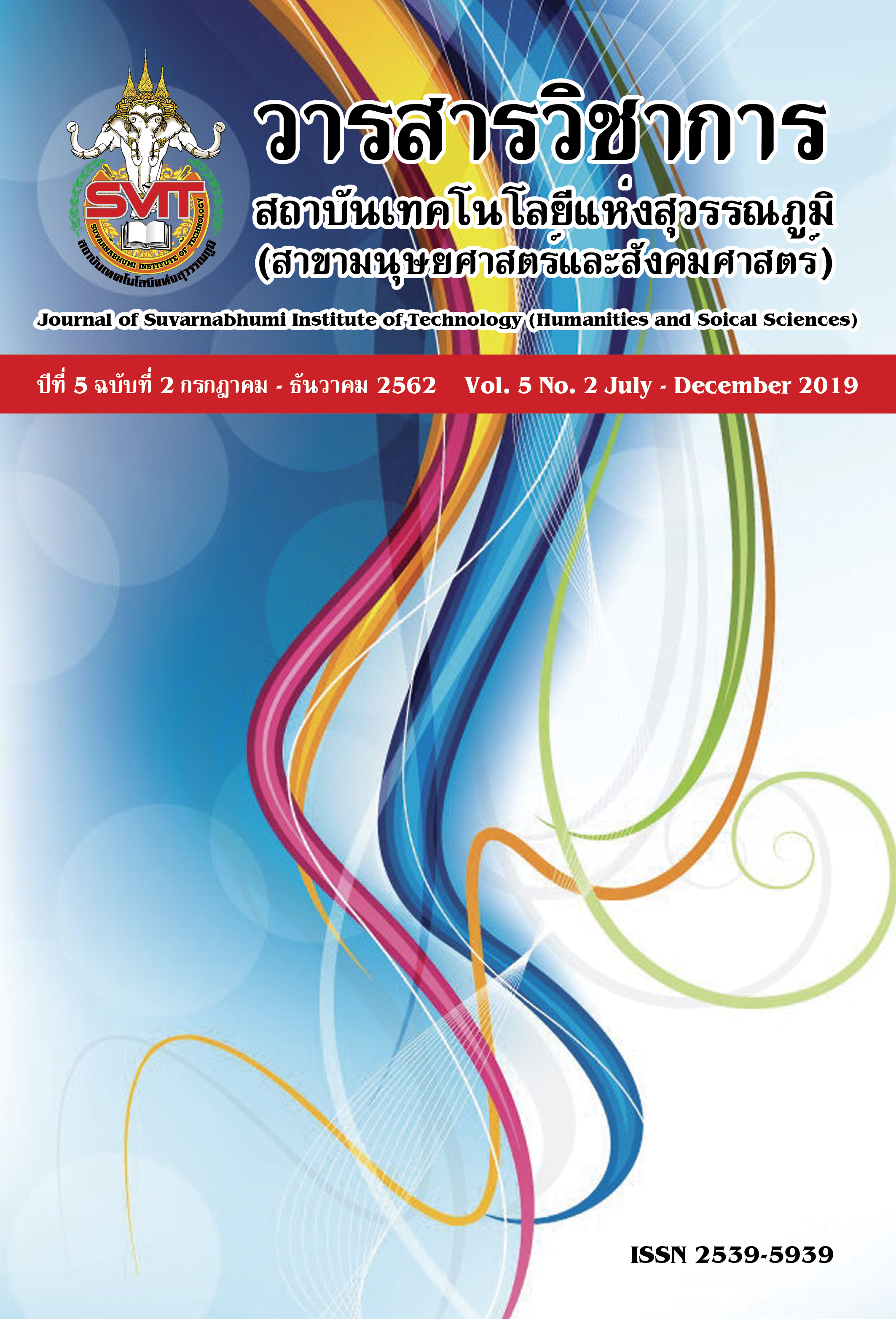การศึกษาเชิงทฤษฎีเกี่ยวกับหลักการและกฎเกณฑ์ทางกฎหมายในการส่งเสริมและคุ้มครอง การลงทุนภายในเขตพัฒนาพิเศษภาคตะวันออก (EEC)
คำสำคัญ:
เขตพัฒนาพิเศษภาคตะวันออก, เขตส่งเสริมการลงทุน, การส่งเสริมการลงทุนบทคัดย่อ
บทความวิชาการเรื่องนี้ เป็นบทความเกี่ยวกับหลักการและกฎเกณฑ์ทางกฎหมายในการส่งเสริมและคุ้มครองการลงทุน มีวัตถุประสงค์ เพื่อศึกษาหลักการและกฎเกณฑ์สากลทางกฎหมาย เปรียบเทียบกับ กฎเกณฑ์และเงื่อนไขการลงทุนภายในเขตพัฒนาพิเศษภาคตะวันออก สำหรับใช้เป็นข้อมูลการพิจารณากำหนดนโยบายหรือมาตรการที่เหมาะสมต่อการลงทุนต่อไป โดยผลการศึกษาพบว่า เขตพัฒนาพิเศษภาคตะวันออกมีวัตถุประสงค์เพื่อพัฒนาโครงสร้างพื้นฐานและพัฒนาเมืองให้เป็นเขตเศรษฐกิจชั้นนำของภูมิภาค และรองรับการลงทุนอุตสาหกรรมเป้าหมายของประเทศ และกิจกรรมทางเศรษฐกิจอื่น ๆ ซึ่งจะสนับสนุนการยกระดับความสามารถในการแข่งขันของประเทศ รวมถึงการอำนวยความสะดวกแก่นักลงทุนทั้งในประเทศและต่างประเทศ โดยพระราชบัญญัติเขตพัฒนาพิเศษภาคตะวันออก พ.ศ. 2561 ได้กำหนดหลักการและกฎเกณฑ์ของสิทธิประโยชน์เพื่อส่งเสริมบรรยากาศของการลงทุน และเชิญชวนนักลงทุนให้เข้ามาลงทุนในเขตพัฒนาพิเศษภาคตะวันออก ด้วยการเสนอสิทธิประโยชน์ทางภาษีและสิทธิประโยชน์อื่นที่มิใช่ทางภาษีไว้หลายประการ รวมถึงการไม่กำหนดกฎเกณฑ์ทางลบที่จะสร้างความไม่มั่นใจแก่นักลงทุนไว้ในกฎหมายฉบับดังกล่าวด้วย
เอกสารอ้างอิง
คณะรักษาความสงบแห่งชาติ. (2560). คำสั่งหัวหน้าคณะรักษาความสงบแห่งชาติ ที่ 2/2560 เรื่อง การพัฒนาระเบียงเศรษฐกิจพิเศษภาคตะวันออก
จุมพต สายสุนทร. (2546). กฎหมายระหว่างประเทศ เล่ม 1. กรุงเทพฯ : สำนักพิมพ์วิญญูชน.
จุมพต สายสุนทร. (2553). รายงานการศึกษาฉบับสมบูรณ์ เรื่อง หนังสือสัญญาระหว่างประเทศที่ต้องได้รับความเห็นชอบจากรัฐสภา. กรุงเทพฯ : บริษัท มิสเตอร์ก๊อบปี้ (ประเทศไทย) จำกัด.
โชติรส เพศประเสริฐ. (2545). สนธิสัญญาส่งเสริมและคุ้มครองการลงทุนระหว่างไทย – จีน : วิเคราะห์ภายใต้กฎหมายระหว่างประเทศ. (วิทยานิพนธ์นิติศาสตรมหาบัณฑิต, คณะนิติศาสตร์ มหาวิทยาลัยธรรมศาสตร์).
พระราชบัญญัติการเพิ่มขีดความสามารถในการแข่งขันของประเทศสำหรับอุตสาหกรรมเป้าหมาย พ.ศ. 2560
พระราชบัญญัติเขตพัฒนาพิเศษภาคตะวันออก พ.ศ. 2561
พระราชบัญญัติส่งเสริมการลงทุน พ.ศ. 2520, (ฉบับที่ 2) พ.ศ. 2534, (ฉบับที่ 3) พ.ศ. 2544, (ฉบับที่ 4) พ.ศ. 2560
พรสันต์ เลี้ยงบุญเลิศชัย. (2556). หลักสุจริตในระบบกฎหมาย. จุลนิติ, 10(6), 43–55.
แพรวไพลิน วงษ์สินธุวิเศษ และ ณัชพล จรูญพิพัฒน์กุล. (2560). Middle Income Trap: กับดักเศรษฐกิจที่รอการก้าวข้าม. เข้าถึงได้จาก http://www.bangkokbiznews.com/blog/detail/643029
มุจลินท์ นวลนิ่ม และ ศันสนีย์ แก้วพรสวรรค์. (2553). ความตกลงเพื่อส่งเสริมและคุ้มครองการลงทุนของไทย (BITs) : พันธะและนัยเชิงนโยบาย. กรุงเทพฯ : ธนาคารแห่งประเทศไทย.
วิศิษฎ์ ธนากูรเมธา. (2540). การคุ้มครองการลงทุนต่างชาติโดยผ่านสนธิสัญญาทวิภาคี (BIT). (วิทยานิพนธ์นิติศาสตรมหาบัณฑิต, คณะนิติศาสตร์ มหาวิทยาลัยธรรมศาสตร์).
ศิวรัตน์ เล้าประเสริฐ. (2538). ความคุ้มครองทางการทูตแก่ผู้ลงทุนต่างชาติภายใต้กฎหมายระหว่างประเทศ. (วิทยานิพนธ์นิติศาสตรมหาบัณฑิต, คณะนิติศาสตร์ มหาวิทยาลัยธรรมศาสตร์).
สำนักงานคณะกรรมการพัฒนาการเศรษฐกิจและสังคมแห่งชาติ. (2559). แผนงานพัฒนาระเบียงเศรษฐกิจภาคตะวันออก (พ.ศ. 2560-2564). กรุงเทพฯ : สำนักงานคณะกรรมการพัฒนาการเศรษฐกิจและสังคมแห่งชาติ.
สำนักงานคณะกรรมการส่งเสริมการลงทุน. (2560). คู่มือการลงทุนในพื้นที่ระเบียงเศรษฐกิจพิเศษภาคตะวันออก. กรุงเทพฯ : สำนักงานคณะกรรมการส่งเสริมการลงทุน.
สำนักงานคณะกรรมการส่งเสริมการลงทุน. (2561 ก). ประกาศคณะกรรมการส่งเสริมการลงทุนที่ 6/2561 ลงวันที่ 3 สิงหาคม 2561 เรื่อง มาตรการส่งเสริมการลงทุนในพื้นที่เขตพัฒนาพิเศษภาคตะวันออก (EEC)
สำนักงานคณะกรรมการส่งเสริมการลงทุน. (2561 ข). ประกาศคณะกรรมการส่งเสริมการลงทุนที่ 8/2561 ลงวันที่ 14 กันยายน 2561 เรื่อง การผ่อนผันหลักเกณฑ์ที่ตั้งสำหรับกิจการเป้าหมายในเขตนวัตกรรมระเบียงเศรษฐกิจพิเศษภาคตะวันออก (Eastern Economic Corridor of Innovation หรือ EECi) ตามประกาศคณะกรรมการส่งเสริมการลงทุนที่ 6/2561
สำนักงานรัฐมนตรี กระทรวงการคลัง. (2559). มติคณะรัฐมนตรี 28/6/2559. เข้าถึงได้จาก http://www.ofm. mof.go.th/images/stories/ pdf/98907_590628.pdf
สุจิตรา ใจเอื้อ. (2559). การตกไปแห่งรากฐานของสัญญา. วารสารธรรมศาสตร์, 35, 130–142.
Adriana Sánchez Mussi. (2008). International Minimum Standard of Treatment. Retrieved from https://asadip.files. wordpress.com/ 2008/09/mst.pdf.
Bernardo M. Cremades. (2012). GOOD FAITH IN INTERNATIONAL ARBITRATION. Retrieved from https://digitalcommons.wcl.american.edu/cgi/viewcontent.cgi?referer=https://www.google.co.th/&httpsredir=1&article=1783&context=auilr
Carlos M. Correa. (2004). Bilateral Investment Agreements: Agents of new global standards for the protection of intellectual property rights? Form to https://www.ictsd.org/sites/ default/files/downloads/2008/08/correa-bits-august-2004.pdf
John Dugard. (2006). Articles on Diplomatic Protection. Retrieved from http://legal.un.org/ avl/ha/ adp/adp.html
LawTeacher. (2013). The national treatment standard. Retrieved from https://www. lawteacher.net/free-law-essays/international-law/the-national-treatment-standard.php? vref=1
The World Trade Organization (WTO). (n.d.). Principles of the trading system. Retrieved from https://www.wto.org/english/theWTO_e/whatis_e/tif_e/fact2_e.htm
Vienna Convention on the Law of Treaties 1969
Young-Joon Mok. (1989). The Principle of Reciprocity in the United Nations Convention on the Recognition and Enforcement of Foreign Arbitral Awards of 1958. Retrieved from https://scholarlycommons.law.case.edu/cgi/viewcontent.cgi?article=1687&context=jil
ดาวน์โหลด
เผยแพร่แล้ว
ฉบับ
ประเภทบทความ
สัญญาอนุญาต
บทความที่ได้รับการตีพิมพ์เป็นลิขสิทธิ์ของวารสารวิชาการ สถาบันเทคโนโลยีแห่งสุวรรณภูมิ
ข้อความที่ปรากฏในบทความแต่ละเรื่องในวารสารวิชาการเล่มนี้เป็นความคิดเห็นส่วนตัวของผู้เขียนแต่ละท่านไม่เกี่ยวข้องกับสถาบันเทคโนโลยีแห่งสุวรรณภูมิ และคณาจารย์ท่านอื่นๆในสถาบันฯ แต่อย่างใด ความรับผิดชอบองค์ประกอบทั้งหมดของบทความแต่ละเรื่องเป็นของผู้เขียนแต่ละท่าน หากมีความผิดพลาดใดๆ ผู้เขียนแต่ละท่านจะรับผิดชอบบทความของตนเองแต่ผู้เดียว





